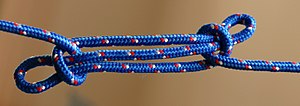Sheepshank
A shank is a used to shorten a rope or take up slack, it can also be used to reduce the strain on a weakened part of a rope. The sheepshank knot is not stable. It will fall apart under too much load or too little load.
The sheepshank is tied in the bight of a rope for shortening a rope, taking up the slack, or to pass the strain over a weakened or frayed part of the rope.


Disadvantages
The sheepshank was developed before the use of modern "slippery" synthetic ropes rather use a dogshank.
Variants
Man-o'war sheepshank
The man-o'war sheepshank is a sheepshank knot with a Handcuff knot in the middle. This configuration with the half-hitches formed close to the central knot is used in rope rescue and is called a Fireman's chair knot.
Sheepshank with Marlinspike hitches
This version of the sheepshank is tied by using slipknots instead of half-hitches. It is one of the safest sheepshank variations.
Kamikaze knot
The kamikaze knot is a variant of the sheepshank. To make a kamikaze knot, a sheepshank is first tied, keep the tension on the sheepshank so it will not slip out, the middle rope is sliced.
This allows climbers rappelling down cliff faces to keep most of the rope used for the rappel, by tying the knot at the top, and shaking the rope when they reach the bottom. The shaking disconnects the knot at the top, allowing the longer section of rope to fall and only a small amount of rope is left at the top of the cliff.
NoteThin or slippery rope is unsuitable for the kamikazi knot, as it can easily slip, and the knot should only be used when desperately needed.
Dogshank

The dogshank, or sheepshank pouch knot, is a variant of the sheepshank where the eyes formed at each end have the ends of the rope passed through them to prevents the knot from spilling. At least one end of the rope must be available to tie or untie this knot. It is mostly useful for the hammock-like space it creates.
The dogshank can be thought of as two opposite bowlines where
- the two ends provide the respective standing lines each with its pinching turn, and
- the two elbows of the Z-folded middle part provide the bights that pass through the turns and come back from around the standing lines.
The dogshank can also be thought of as two opposite sheet bends where
- the two ends provide the self-crossing line in each sheet bend, while
- the two elbows of the Z-folded middle part provide the non-crossing other line.
Further reading:
- Project Gutenberg (September 21, 2004). The Project Gutenberg eBook, Knots, Splices and Rope Work, by A. Hyatt Verrill. Retrieved November 6, 2005. The Dogshank is shown in Figure 82.
External links
- Sheepshank & Variants
- Boatsafe.com
- Project Gutenberg (September 21, 2004). The Project Gutenberg eBook, Knots, Splices and Rope Work, by A. Hyatt Verrill. Retrieved November 6, 2005. Though the name's a little different, the Sheepshank described above is shown in Figure 79.
- Scouting Resources. Sheepshank. Retrieved December 11, 2006. Shows diagrams with accompanying text.
